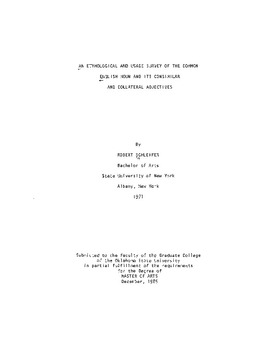| dc.description.abstract | This work serves as a preliminary investigation into an area that has hitherto been only peripherally explored--the etymological and usage relationships between common nouns, consimilar adjectives, and collateral adjectives. Through this study, attempt to answer--or at least bring attention to--such questions as, Why do some nouns have consimi Jar adjectives, others collateral adjectives, and still others both consimilar and collateral adjectives? What etymological, morphological, and phonological similarities and differences do common nouns, consimilar adjectives, and collateral adjectives manifest? How knowledgeable are native speakers of English about consimilar and collateral adjectives? And, given a choice, which types of adjectives would such speakers prefer to use? While my answers to these questions are not always complete or satisfactory, by recording my methods, speculations, expectations, and mistakes, I hope that future researchers can succeed where I have failed. This project grows out of my lifelong interest in words and etymology, and eleven years experience working in industry as a service engineer, service manager, and technical writer. Linguistically, the more I learned about common nouns, consimilar adjectives, and collateral adjectives, the more I discerned certain etymological and usage patterns in these categories of words; and, professionally, the more attentively I listened to co-workers� choices of nouns and adjectives, the more I perceived that those persons who had attained high professional or scholastic positions tended to use a relatively high percentage of collateral adjectives in comparison to consimilar adjectives while those persons who had not attained such high positions tended, proportionally, to use a higher percentage of consimilar adjectives. wondered if these perceptions were correct and what, if any, were the etymological and usage correlations between common nouns, consimilar adjectives, and collateral adjectives. In searching the literature for studies on this topic, I was unable to find one article or one chapter in any text bearing on these relationships. Specifically, I examined numerous composition and linguistic texts (see A SELECTED BIBLIOGRAPHY), every issue of The Journal of the Dictionary Society of North America, Verbatim, and The Sesquipedalian; and I conducted two ERIC searches using such descriptors as 11collateral adjectives, 11 11adjectives, 11 11nouns, 11 11etymology, 11 and 11 usage. 11 While I observed that an increasing number of English grammars (see, for example, Stageberg, 1981) and a plethora of journal articles (see Smith, 1981; Drysdale, 1979) analyze the morphology, phonology, and etymology of nouns and adjectives, no article, grammar, etymologicon, word-frequency study, or dictionary that I consulted save Funk~ Wagnalls 1 Standard College Dictionary (Funk~ Hagnalls, 1963, pp. xx, 265, passim) and David Gold 1 s 11The Ordering of Lexemes in a Dictionary11 (Gold, 1979) even mentions collateral adjectives. And I have yet to speak with any linguist or grammarian save Laurence Urdang (Urdang, 1981) who has been acquainted with collateral adjectives. In short, I am embarking on an expedition into what is essentially uncharted territory, and the ultimate value of my study, if indeed it has any, may very well lie not in the answers it furnishes but in the questions it raises. | |
